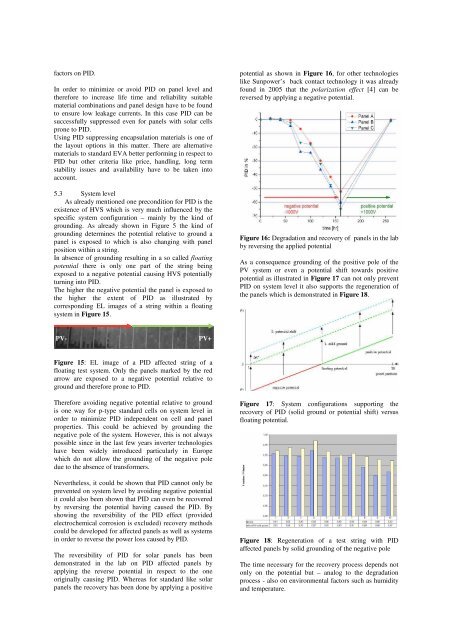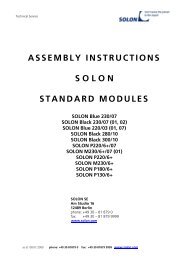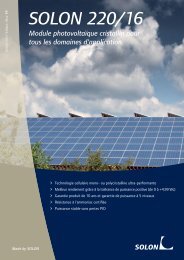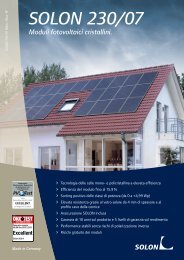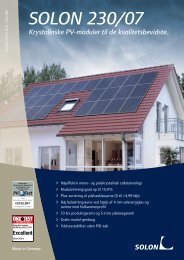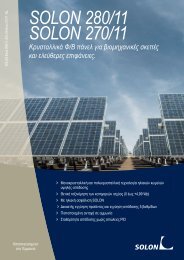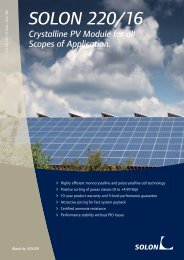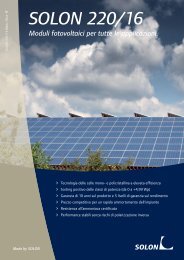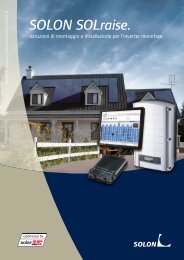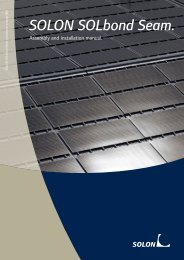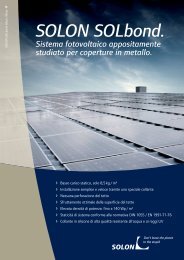Potential Induced Degradation Of solar Cells And panels - Solon
Potential Induced Degradation Of solar Cells And panels - Solon
Potential Induced Degradation Of solar Cells And panels - Solon
You also want an ePaper? Increase the reach of your titles
YUMPU automatically turns print PDFs into web optimized ePapers that Google loves.
factors on PID.<br />
In order to minimize or avoid PID on panel level and<br />
therefore to increase life time and reliability suitable<br />
material combinations and panel design have to be found<br />
to ensure low leakage currents. In this case PID can be<br />
successfully suppressed even for <strong>panels</strong> with <strong>solar</strong> cells<br />
prone to PID.<br />
Using PID suppressing encapsulation materials is one of<br />
the layout options in this matter. There are alternative<br />
materials to standard EVA better performing in respect to<br />
PID but other criteria like price, handling, long term<br />
stability issues and availability have to be taken into<br />
account.<br />
5.3 System level<br />
As already mentioned one precondition for PID is the<br />
existence of HVS which is very much influenced by the<br />
specific system configuration – mainly by the kind of<br />
grounding. As already shown in Figure 5 the kind of<br />
grounding determines the potential relative to ground a<br />
panel is exposed to which is also changing with panel<br />
position within a string.<br />
In absence of grounding resulting in a so called floating<br />
potential there is only one part of the string being<br />
exposed to a negative potential causing HVS potentially<br />
turning into PID.<br />
The higher the negative potential the panel is exposed to<br />
the higher the extent of PID as illustrated by<br />
corresponding EL images of a string within a floating<br />
system in Figure 15.<br />
PV- PV+<br />
Figure 15: EL image of a PID affected string of a<br />
floating test system. Only the <strong>panels</strong> marked by the red<br />
arrow are exposed to a negative potential relative to<br />
ground and therefore prone to PID.<br />
Therefore avoiding negative potential relative to ground<br />
is one way for p-type standard cells on system level in<br />
order to minimize PID independent on cell and panel<br />
properties. This could be achieved by grounding the<br />
negative pole of the system. However, this is not always<br />
possible since in the last few years inverter technologies<br />
have been widely introduced particularly in Europe<br />
which do not allow the grounding of the negative pole<br />
due to the absence of transformers.<br />
Nevertheless, it could be shown that PID cannot only be<br />
prevented on system level by avoiding negative potential<br />
it could also been shown that PID can even be recovered<br />
by reversing the potential having caused the PID. By<br />
showing the reversibility of the PID effect (provided<br />
electrochemical corrosion is excluded) recovery methods<br />
could be developed for affected <strong>panels</strong> as well as systems<br />
in order to reverse the power loss caused by PID.<br />
The reversibility of PID for <strong>solar</strong> <strong>panels</strong> has been<br />
demonstrated in the lab on PID affected <strong>panels</strong> by<br />
applying the reverse potential in respect to the one<br />
originally causing PID. Whereas for standard like <strong>solar</strong><br />
<strong>panels</strong> the recovery has been done by applying a positive<br />
potential as shown in Figure 16, for other technologies<br />
like Sunpower’s back contact technology it was already<br />
found in 2005 that the polarization effect [4] can be<br />
reversed by applying a negative potential.<br />
Figure 16: <strong>Degradation</strong> and recovery of <strong>panels</strong> in the lab<br />
by reversing the applied potential<br />
As a consequence grounding of the positive pole of the<br />
PV system or even a potential shift towards positive<br />
potential as illustrated in Figure 17 can not only prevent<br />
PID on system level it also supports the regeneration of<br />
the <strong>panels</strong> which is demonstrated in Figure 18.<br />
Figure 17: System configurations supporting the<br />
recovery of PID (solid ground or potential shift) versus<br />
floating potential.<br />
Figure 18: Regeneration of a test string with PID<br />
affected <strong>panels</strong> by solid grounding of the negative pole<br />
The time necessary for the recovery process depends not<br />
only on the potential but – analog to the degradation<br />
process - also on environmental factors such as humidity<br />
and temperature.


